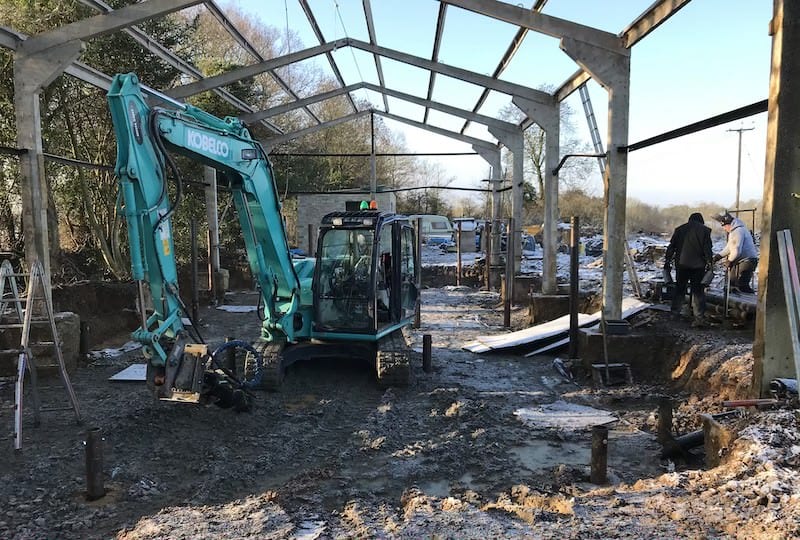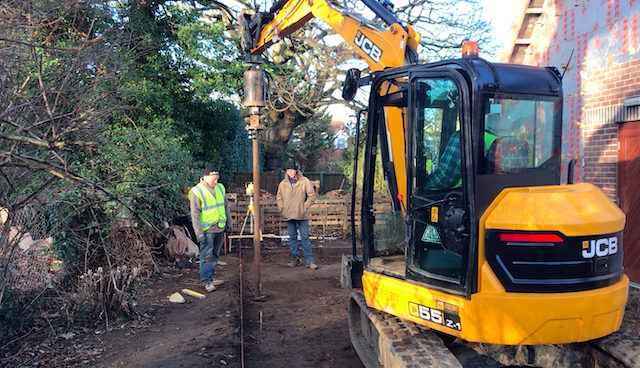Over nearly two centuries screw piles have come a long way. Originally, they were used as a means to built lighthouses in unstable ground, today they can be used for projects ranging from large commercial buildings all the way down to tiny garden sheds.
In this blog we aim to share more info on screw piles with you.
1) Screwpiles can be installed in almost any weather conditions
If you have ever been involved with a construction project you will know that bad weather weather normally stops play.
However, this is not the case with screw piles.
This is because aside from ground preparation, there is no excavation with screw piles and no need to remove excess waster from the site.
If you are installing piles using an excavator you will be in a warm cab and can install screw piles in almost any weather conditions.
2) Screwpiles can be used for houses
Some people are surprised to discover that screw piles can be used as foundations for residential buildings.
In part this could be because the UK housing industry is generally slow to adopt new technology and ideas. It often appears to be the same big players sticking to the same old cookie cutter formula of house building.

With that said, you can build houses on screw piles, in fact houses and extensions are being built on screw piles in the UK today.
However, the use of screw piles for housing in the UK is typically due to unique specifications outlined by the structural engineer. Many structural engineers today are turning to screw piles when overcoming difficult soil conditions, listed buildings or when tree roots are a factor on a project.
NOTE- Whether helical piles are a viable option for building a house will depend a great deal on the soil conditions of the project as well as the build style. In some instances they may not be suitable
3) Screwpiles are often used when tree preservation is a factor
A tree preservation order can put a complete stop to your construction project.
This is because the digging of foundations may disturb the root system and eventually kill the tree in question.

In addition, foundations often need to go below the root activity of a tree otherwise the the roots system may cause heave and damage the foundation system.
Screw piles can often come overcome the issue. By screwing way past the root activity the heave can be avoided and because of the lack of digging the tree root system suffers minimal disturbance meaning your structure can be built and the tree lives on.
4) Screwpiles can be used for a wide variety of applications
Screwpiles were originally designed to solve the problem of building on unstable ground, specifically for building lighthouses on sanding banks.

Shortly after the design was used to build piers and later bridges. since then the range of applications had been wide and varied including:
- Underpinning to counter subsidence
- House foundations
- Piers
- Fencing
- Sign posts
- Decking
- Garages
- Bridges
- Retaining walls
- Solar panels
- Sheds
- Garden houses
- House extensions
- Nature walkways
And more…
5) Screwpiles are growing in popularity
The use of screw piles has been growing in recent years, in part this is due to a growing awareness among engineers of their many uses and applications.
It is predicated that the popularity will continue to grow for a number of reasons:
The ability of helical piles to overcome various engineering challenges like loose soil conditions, building around listed trees and buildings, foundation solutions in flood prone areas.
Secondly the speed and reduction of costs on certain installs make screw piles increasingly attractive. This is especially noticeable for the contractors that install the piles, who often comment on the speed of install once they are familiar with the process.
Finally, the Reduced cost and improved quality and design of the product is making it a viable option.